Click image for BBB rating
See our Privacy Policy
cool="cool" width="800" height="6808" border="0" cellpadding="0" cellspacing="0" gridx="16" showgridx="showgridx" usegridx="usegridx" gridy="16" showgridy="showgridy" usegridy="usegridy" bgcolor="#99ccff">
|
|
|
|
 |
|
|
|
|
|
|
|
Welcome to Spaightwood Galleries, Inc.
120 Main Street, Upton MA 01568-6193
|
|
|
In the late 1920s and the 1930s, Miró was enthuiastically exploring Surrealisn as a means of transcending the limits of normal vision, but this exploration normally took place in paint and collage. Normally, happily, does not mean exclusively, as you can see in the works below. During this decade, Miró experimented with pochoir, etching, lithography, and linocut, creating his first and only linocur in 1938. In 1929 and 1930, he made his first five lithographs, all in black and white ink and published in 1930. For color, Miró was exploring using the pochoir (stencil), and experimenting with etching in black and white and in color. In his pochoirs, all of the color is brushed on, giving the print the surface of a gouache. This technical experimentation coincided with his involvement in the Surrealist movement and, even more so, the Surrealist vision. It also coincided with the Spanish Civil War (Miró was a Republican Loyalist and hated fascists of all stripes, particularly Franco, who would outlaw the teaching of Catalan in the public schools during his long reign), which inspired Miró to create one of his most explicitly political works, a powerful pochoir designed to elicit support for the Spanish Republic, under attack by Franco in a war that was turning into a testing ground for the larger war to come as the German Air Force tried out various bombing strategies and the Western Democracies did nothing (see below).
|
|
|
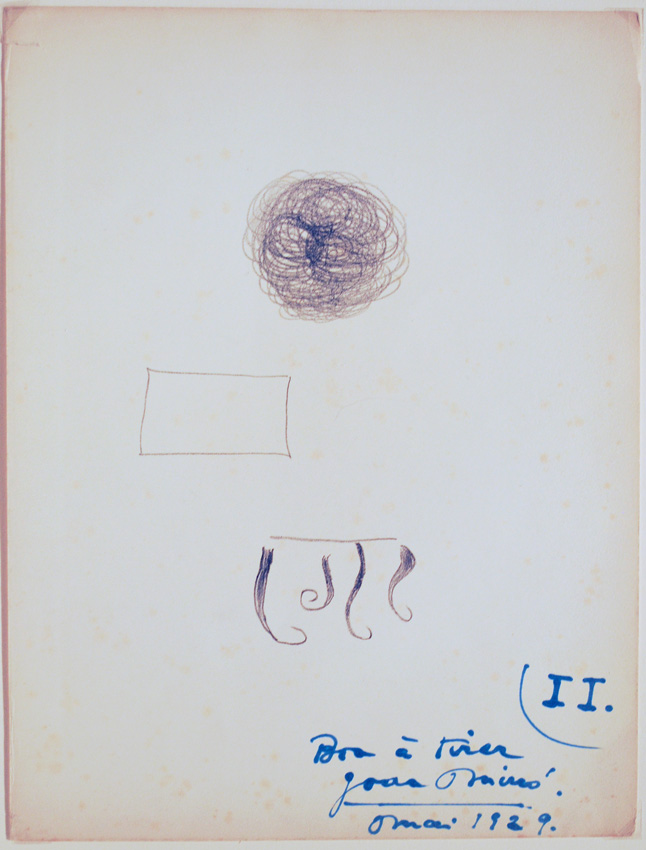 |
|
|
|
|
Lithograph I (it did not otherwise have a title), was a stand-alone work published by Christian Zervos in Paris in 1930. Since two of our impressions are dated 1929, it seeems likely that these actually should be counted as Miró's first four lithographs, executed in 1929 to accompany a a poem, L'Arbre des Voyageurs, by his friend, the Surrealist poet Tristan Tzara—with whom he would collaborate again in a set of etchings in 1947 for L'Antitête—published in 1930 in an edition of 101 impressions. They are among his most Surrealist works. Each of the books was signed but the individual lithographs were not. Compared to many of Miró's later illustrated books, this one is on the small side, measuring 9-3/4 x 6-3/8 inches. In addition, there was a separate printing of each of the lithographs in a numbered edition of 10. We present the complete set of 4 in the Bon à tirer proofs, the first of which is signed by Miró and dated 1929. These four impressions, Miró's final versions of the lithographs, were meant to serve as models for the printers when printing the rest of the edition. They were printed on heavy wove paper of varying sizes but substantially larger than the pages of the book edition. The first of these, L'Arbre des Voyageurs I (M. 2), is signed in blue ink and labeled Bon à tirer and numbered II lower right. There is some foxing on the sheet (the other 3 sheets are clean). L'Arbre des Voyageurs was Miró's first artist's book. Image size: 358x272mm (14-1/8x10-11/16 inches). Price: Please call or email for current pricing information.
We invite those wishing to purchase the entire set to contact us for a special price.
|
|
|
|
|
|
|
|
|
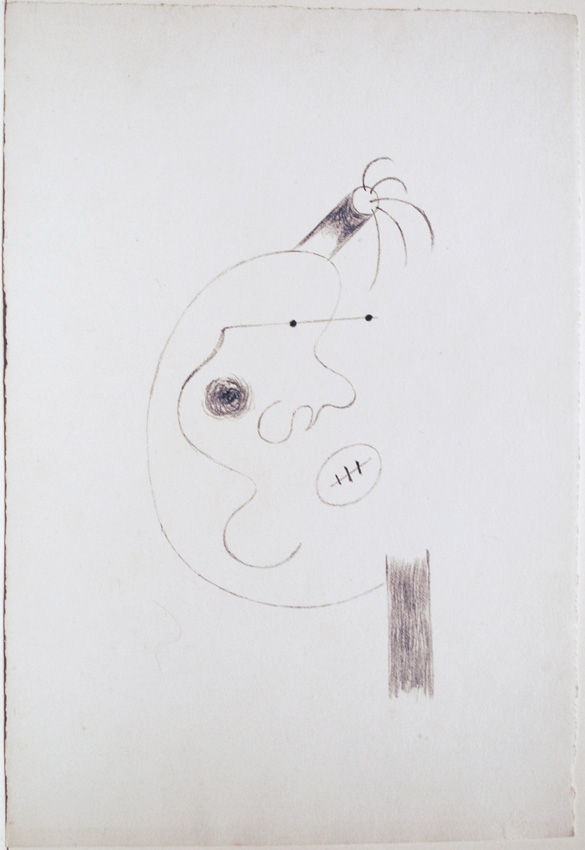 |
|
L'Arbre des Voyageurs II (M. 3), published in 1930 in an edition of 101 impressions. Each of the books was signed but the individual prints were not. They are among his most Surrealist works. Compared to many of Miró's later illustrated books, this one is on the small side, measuring 9-3/4 x 6-3/8 inches. In addition, there was a separate printing of each of the lithographs in an edition of 10. We present the complete set of 4 in the Bon à tirer proofs, the first of which is signed by Miró and dated 1929. These four impressions, Miró's final versions of the piece, were meant to serve as models for the printers when printing the rest of the edition. They were printed on heavy wove paper of varying sizes but substantially larger then the book edition. Image size: 349x240mm (13-11/16 x 9-3/8 inches). Price: Please call or email for current pricing information.
We invite those wishing to purchase the entire set to contact us for a special price.
|
|
|
|
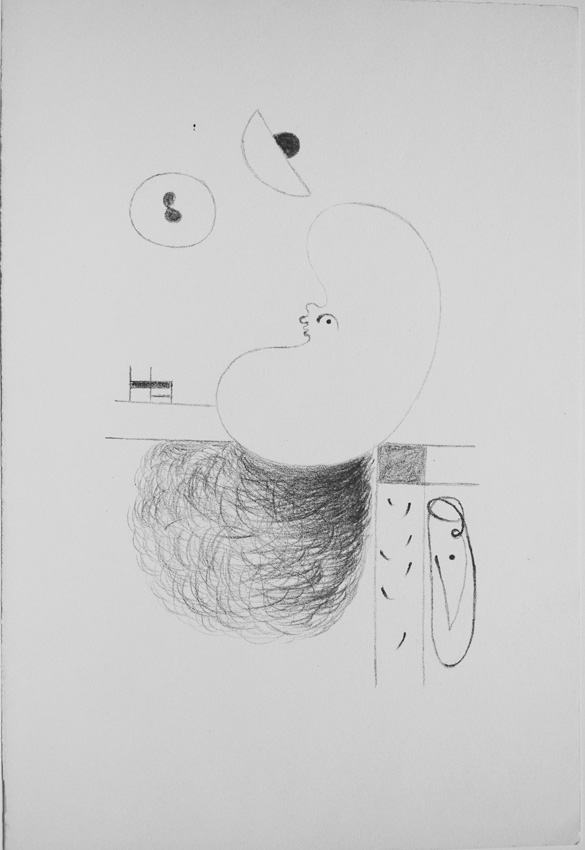 |
|
L'Arbre des Voyageurs III (M. 4), published in 1930 in an edition of 101 impressions. Each of the books was signed but the individual prints were not. They are among his most Surrealist works. Compared to many of Miró's later illustrated books, this one is on the small side, measuring 9-3/4 x 6-3/8 inches. In addition, there was a separate printing of each of the lithographs in an edition of 10. We present the complete set of 4 in the Bon à tirer proofs, the first of which is signed by Miró and dated 1929. These four impressions, Miró's final versions of the piecee, were meant to serve as models for the printers when printing the rest of the edition. They were printed on heavy wove paper of varying sizes but substantially larger then the book edition. Image size: 350x240mm (13-3/4 x 9-3/8 inches). Price: Please call or email for current pricing information.
We invite those wishing to purchase the entire set to contact us for a special price.
|
|
|
|
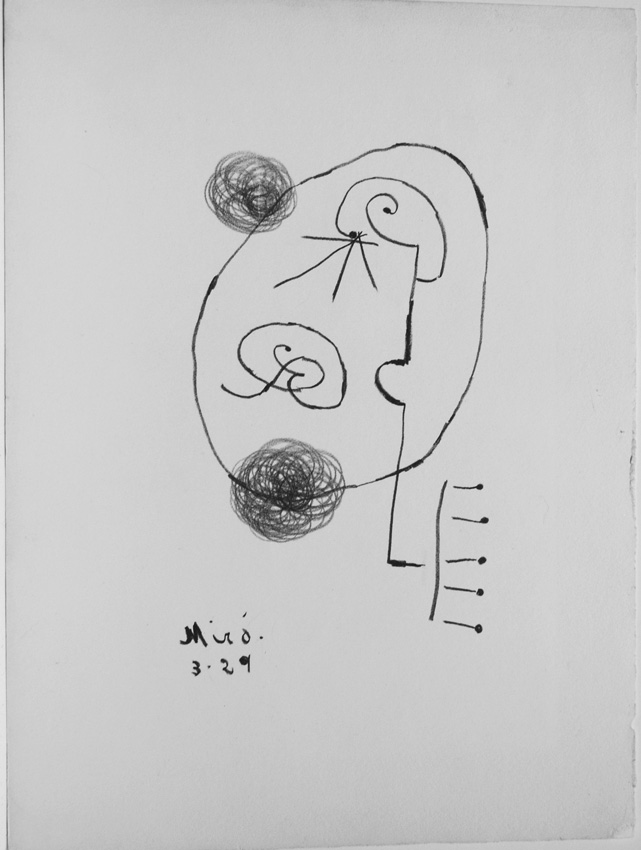 |
|
L'Arbre des Voyageurs IV (M. 5), published in 1930 in an edition of 101 impressions. Each of the books was signed but the individual prints were not. They are among his most Surrealist works. Compared to many of Miró's later illustrated books, this one is on the small side, measuring 9-3/4 x 6-3/8 inches. In addition, there was a separate printing of each of the lithographs in an edition of 10. We present the complete set of 4 in the Bon à tirer proofs, the first of which is signed by Miró and dated 1929. These four impressions, Miró's final versions of the piecee, were meant to serve as models for the printers when printing the rest of the edition. They were printed on heavy wove paper of varying sizes but substantially larger then the book edition. Signed and dated in the stone "Miró - 3-29." Image size: 358x268mm (14-1/8 x 10-9/16 inches). Price: Please call or email for current pricing information.
We invite those wishing to purchase the entire set to contact us for a special price.
|
|
|
|
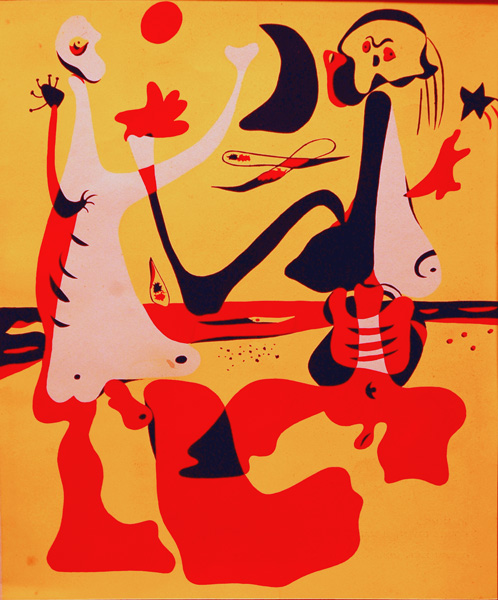 |
|
Personnages devant la mer / Figures by the sea shore (Dupin 13). Original color pochoir, 1934. Published in December 1934 in the art journal D'Aci i D'Alla; printed by J. Mateu, Pochoir Publicity Art, Barcelona, 1934. The number impressions of this pochoir is unknown, as is the number that might have been destroyed during the Spanish Civil War soon to follow, What we do know is that impressions of this piece are rarely available in the art market (this is only the second impression of this that we have seen since 1975). This is one of Miró's most surreal prints showing a male and a female figure reaching out for each other in lust or terror while the leg of the female figure on the right seems to interpenetrate the leg of the male figure on the left. A rare and beautiful print with the surface texture of a gouache slightly marred by two small flaws in the shape of spots in the lower left corner by the heel of the male figure and on the right side of the white torso of the male figure. The spot on the torso is not red but gray; the spot by the heel is a discoloration slightly darker than the yellow where it occurs. Image size: 330x285mm. Price: Please call or email for current pricing information
|
|
|
|
 |
|
Cahiers d'art I / Surrealist Composition I (Dupin 14). Original color pochoir, 1934. 40 signed and numbered impressions plus c. 1200 unsigned impressions . There is a full-page color reproduction of this work in Gilbert Kaplan's Surrealist Prints (NY: Abrams, 1997). A rare and beautiful print with the surface texture of a gouache. Image size: 380x280mm. Price: Please call or email for current pricing information.
|
|
|
|
|
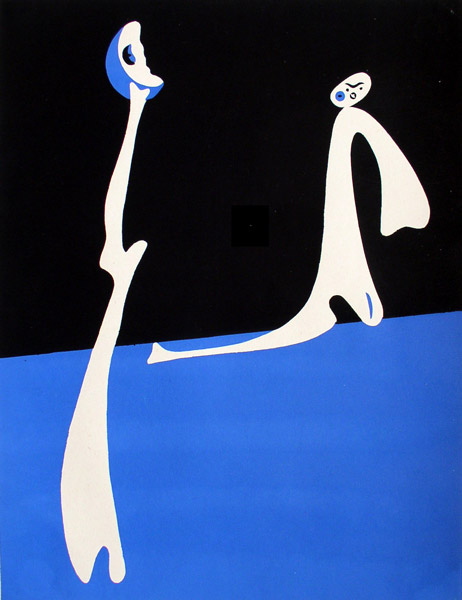 |
|
Cahiers d'art II / Surrealist Composition II (Dupin 15). Original color pochoir, 1934. 40 signed and numbered impressions plus c. 1200 unsigned impressions . There is a full-page color reproduction of this work in Gilbert Kaplan's Surrealist Prints (NY: Abrams, 1997). It is also reproduced on the dust jacket of the book. A rare and beautiful print with the surface texture of a gouache. Image size: 380x280mm. Price: Please call or email for current pricing information.
|
|
|
|
|
 |
|
|
|
The best book on Surrealist printmaking and makers; it illustrates the two Miró pochoirs above plus several others by Miró and works by Max Ernst, Jean Arp, Rene Magritte, and others. Price: Please call or email for current pricing information (new in shrink wrap; very good used copies available at Please call or email for current pricing information).
|
|
|
|
 |
|
Aidez L'Espagne! (Dupin 17). Original color pochoir, 1937. Published at the height of the Spanish Civil War as a loose insert in Cahier d'art (1937) to draw support for the Republican government, then under attack by Franco (aided by Nazi and Fascist "volunteers"). Printed by Imprimerie moderne, Paris. A rare and beautiful print with the surface texture of a gouache, color fresh and unfaded, in excellent condition. During the Museum of Modern Art's 100th anniversary exhibition for Miro, they also mounted a small print show. This print was reproduced on the cover of their brochure in black and white; in 1999, when they mounted a large exhibition to celebrate their acquisition of Miro's first series of 8 "Red and Black" etchings, they again included this work and Art on Paper reproduced it in color in their feature about the show. Not to be outdone, the Metropolitan Museum of Art reproduced it in full color on the cover of their March-April 2007 Calendar. More recently, it was featured in Joan Miró: The Ladder of Escape (Washington, D.C.: The National Gallery, 2011) and when we received the catalog acompanyuing the exhibition, we discovered why their advertisements for the year's shows featured a reproduction of this pochoir: the introduction begins on p. 17; facing it is a full-page reproduction of this work. The text uses this piece as a way of getting into Miró's mind-set in these years.
|
|
|
|
|
|
|
One of Miro's most important works (one of 60 signed impressions was recently offered for sale for Please call or email for current pricing information). The text beneath the images reads: "In the present struggle I see, on the Fascist side, spent forces; on the other side, the people whose boundless creative will gives Spain an impetus which will astonish the world." Signed in the plate. Image size: 315x245mm. Price: Please call or email for current pricing information.
|
|
|
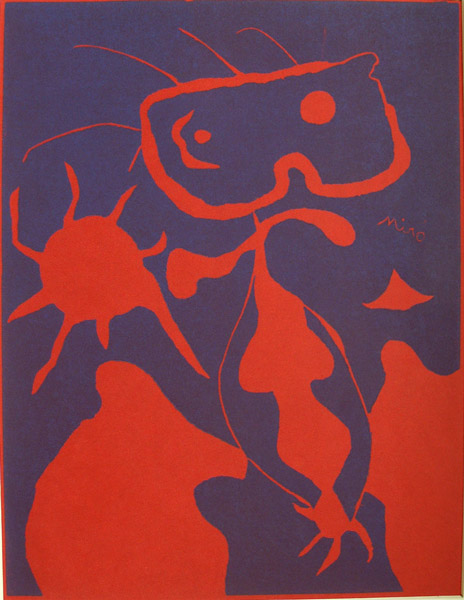 |
|
Femme pour XXe Siecle (Dupin 40). Original color linocut, 1938. Edition size unknown (c. 1200 unsigned impression published in XXe Siecle, 1938. Signed in the block. A beautiful fresh impression. Although Miró was later to do many woodcuts, this is his first and only linocut. There is a reduced size reproduction of this work in different colors in Sam Hunter's book on Miro's Prints. In a late tribute to San Lazzaro, the founder of XXe Siecle, Miro revisited this image. Click here to see. Image size: 320x250mm. Price: Please call or email for current pricing information.
|
|
|
|
|
Spaightwood Galleries, Inc.
To purchase, call us at 1-800-809-3343 (1-508-529-2511 in Upton MA & vicinity) or send an email to spaightwood@gmail.com.
We accept AmericanExpress, DiscoverCard, MasterCard, and Visa.
We also accept wire transfers and paypal.
For directions and visiting information, please call. We are, of course, always available over the web and by telephone (see above for contact information). Click the following for links to past shows and artists. For a visual tour of the gallery, please click here. For information about Andy Weiner and Sonja Hansard-Weiner, please click here.
For a list of special offers currently available, see Specials.
All works are sold with an unconditional guarantee of authenticity (as described in our website listing).
Copyright 2004-2017, Spaightwood Galleries, Inc.
Go back to the top of this page.
Visiting hours: Saturday 10:00 am to 5:00 pm and Sunday noon to 6:00 pm and other times by arrangement.
Please call to confirm your visit. Browsers and guests are welcome.
|
|
|
|
|
|
|
|
|
|
|
|
|
|
|
|
|
|
|
|
|
|
|
|
|
|
|
|
|
|
|
|
|
|









